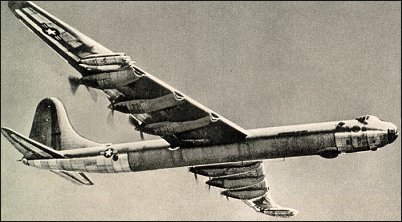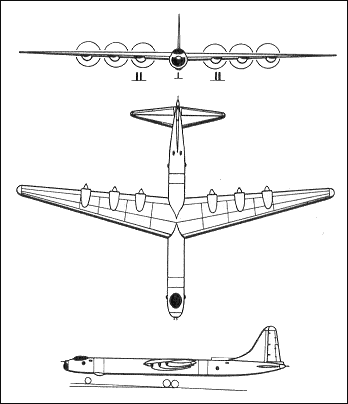|
| The first intercontinental bomber, the Convair B-36 originated from a specification issued on 11 April 1941 which called for an aircraft with ability to carry a maximum bombload of 32659kg and, of even greater importance in view of the state of affairs at that time, to deliver 4536kg of bombs on European targets from bases in the United States. An unrefuelled range of 16093km was a prime requirement, with a maximum speed of 386-483km/h and ceiling of 10670m. Selected from four competing designs, the Consolidated Model 36 featured a pressurised fuselage, and 70.10m span wings with a root thickness of 1.83m to permit in-flight access to the six pusher engines. The aircraft was designed originally with twin fins and rudders, but by the time the XB-36 prototype was ready to be rolled out at Fort Worth, on 8 September 1945, single vertical tail surfaces had been substituted.
First flown on 8 August 1946, the XB-36 had single 2.79m diameter main wheels, also a feature of the YB-36 second prototype on which they were replaced later by the four-wheeled bogies adopted for production aircraft. In this form the aircraft was designated YB-36A and also differed from the first aircraft by introducing a raised cockpit roof. On 23 July 1943 100 aircraft were ordered but it was more than four years before the first of the 22 unarmed crew-trainer B-36A models took off on its maiden flight, on 28 August 1947. Production of the B-36 continued for almost seven years, the last example being delivered to Strategic Air Command on 14 August 1954, and the type was retired finally on 12 February 1959.
| CREW | 16 |
| ENGINE | 6 x P+W R-4360, 2575kW |
| WEIGHTS |
| Take-off weight | 162162 kg | 357508 lb |
| Empty weight | 72051 kg | 158846 lb |
| DIMENSIONS |
| Wingspan | 70.1 m | 230 ft 0 in |
| Length | 49.4 m | 162 ft 1 in |
| Height | 14.3 m | 47 ft 11 in |
| Wing area | 443.3 m2 | 4771.64 sq ft |
| PERFORMANCE |
| Max. speed | 696 km/h | 432 mph |
| Cruise speed | 362 km/h | 225 mph |
| Ceiling | 13700 m | 44950 ft |
| Range w/max.fuel | 16000 km | 9942 miles |
| ARMAMENT | 12-16 20mm machine-guns, 32600kg of bombs |
| Walt Mitchell, e-mail, 22.10.2008 06:13 I was a tail gunner on RB-36s. Fairchild (99th)in '54, Ramey (72nd) '55 /56, Ellsworth (28th)'56. Gunner's primary jobs were gunners only. Exceptions were the forward positions which were manned by the 2nd radio operator, third pilot (extra gunner if no third pilot assigned to crew) and an officer in the nose (sometimes an enlisted weather trained gunner). One gunner was trained in mechanics and then electrical systems before going to gunnery school. Other gunners were trained as turret or gunlaying (Radar) systems technicians before gunnery school. We normally did not work on any equipment other than install the cannons, load ammo and preflight systems prior to gunnery missions. reply | | marvin (GILL) Gilliam, e-mail, 30.08.2008 20:57 99th field maint sq. Fairchild AFB Washington. 1952 /1955. A&P school Sheppard aircraft elect DC&AC.After 10 years Air Force,enlisted US ARMY.Helicopters /CV2 Caribou Vung Tau Vietnam.US Army Civil service Fort Eustis VA. Navy air Resv. Flight Enginer VR 56 NAS NORFOLK. The B-36 was my introductionin into aviation and as a kid had no idea that this B-36 experience would set the aviation standards for the me the rest of my life. The first time I looked at the flight engineers panel in the 36 was my introduction to the real world. FIRST THOUGHT! I'll never learn all this "CRAP"!!!!!This was right up there with that stray round that came up through the floor between my feet in NAM.61st aviation ving tau 1962 /63. reply | | Bob Miller, e-mail, 21.08.2008 22:20 Does anyone know what happened to the static display B-36 that was found at Greater Southwest Int'l Airport (before it was expanded and rebuilt as DFW)? reply |
| Robert E. Jones, e-mail, 30.07.2008 06:18 I was a crew chief on a
RB-36 D model. I was in the 717th bomb recon squardon in the 24th bomb wing of SAC stationed at Ellsworth AFB in Rapid City SD. I was in a flight of RB-36s that flew out of the Azores island accross the Atlantic at one thousand feet above the cold wet north Alnatic on a penetration mission back into the USA to test the air defince command. That is when General Ellsworth, in a 36 several planes ahead of us, crashed into the shore line cliffs in New Foundland.. Rapid City AFB was then renamed Ellsworth AFB. This was a great plane that keep the Russians at bay hence the name Peace Maker - that never dropped a bomb in anger. reply |
|
| | Phil Turner, e-mail, 14.07.2008 05:34 As a kid growing up in Denver, Colorado in the mid 1950's, I remember that the USAF brought one of these to town. Lowry AFB did not have a runway long enough to accomodate the beast, thus it landed at Stapleton Field, the Commercial Airport, Thanks to warm weather and the overall weight of the plane, it literally sank into the Asphalt parking apron and had to be moved out with a pair of very large BullDozers. The last time one landed there! My recollection is that this airplane had the most distinct "sound" of anything flying and you could identify them before you could see them. Also left some interesting con-trails with 6 engines, plus 4 Jets. reply | | stephen russell, e-mail, 15.06.2008 04:16 Seen this in the movie Stragetic Air Command with Jimmy Stewart & John Wayne in Jet Pilot.
Big beast of a plane.
Unique
2 bad Non fly in Retro mode like some B17s do,
Must get one 2 fly to honor Cold War era & USAF crews. reply | | E. Ruggles, e-mail, 21.05.2008 15:05 I went through Aircraft Electrical Repairmen School at Sheppard AFB , Wichita Falls, TX and was told that I would attend Gunnery School after to train as a gunner on the B-36
But after school was shipped to Westover AFB ,Mass and serviced B-52's so I never got to see the Inside of a B-36 or attend gunnery school. Thanks E. Ruggles reply | | Ed Smart, e-mail, 11.05.2008 19:33 The GRB-36J (FICON) carried one RF-84F "parasite" reconnaissance aircraft in the bombay which could be launched and retrieved in flight. The 10,000 range of the B-36 combined with the 2,000 mile range of the RF-84F permitted lengthy reconnaissance missions. reply | | Ken Cochran, e-mail, 08.05.2008 04:20 One day in my home town of Griffin, GA, c1958, while walking home from school,I saw a B-36 flying a few hundred feet off the ground right down the center of our main street, heading east. I could clearly see the pilots. A friend from Arizona says he remembers about the same time seeing B-36's low level across the area around Prescott, AZ. I guess it was some training thing. When I was in Nam, flying Hueys, I bought thru the PX a B-36 balsa kit made in Japan. It has a 10 ft wingspan. I still have the un-built kit in the original box. One of these days I'll build it, when I retire.................. reply | | S/SGT Charles Chapin, e-mail, 21.04.2008 17:47 I was a crew chief on a Rb-36F, was a lot of work to get it off and keep it flying, we carried a 21 ton h-bomb, our service cealing 52000 feet where we were at most of the time, I was very lucky to have 6 very good men working under me, we would fly for 48hrs missions a very long time to say the least, I was in the 99th bomb wing, 346th sqd. at Fairchild afb. reply | | Carl D. Kaartunen, e-mail, 09.09.2007 05:13 It is a beautiful aircraft of the USAF. 6 Turn...4Burn.
I was able to checkout both exterior&Interior of this
beautiful aircraft,which i have wonder thoughts of,while
i was in the USAF a A&P Student @ Chanute AFB ILL. reply | | Dennis OConnor, e-mail, 01.09.2007 01:26 Gerald, I was a tail gunner on B-36's. No we couldn't service engines in flight. If we were low enough, we could go out into the wing thru a crawl space in the bombay, and lower the Landing Gear manually.
Yes the B-36 Was larger than the B-52 I also flew as tailgunner on B-52's. The B-36 was more fun ! reply | | Sgt.KAR98, 21.08.2007 03:17 Was that plane bigger than the B-52 or B-29? reply | | gerald roberts, e-mail, 09.08.2007 02:54 after "airplane and engine school" at sheppard afb in 1951, i went to "dc" then "ac" electric repairman courses at channute afb. i was told that this was the preliminary to becoming a gunner on the b-36. however , i ended up sewart afb ( c-119's) then to korea ( b-26's).
my memory tells me that the gunners on the b-36 crews had other jobs (hence me being an aircraft electrician). i remember that i was told that on the b-36 in flight, that a crewmmber could reach and service an engine if needed. is there a book that can be recommended that woexplain the duties in detail re their responsibilities.
thanks
gerald roberts (s /sgt discharged in 1955) reply |
|
Do you have any comments?
|
| 
COMPANY
PROFILE
All the World's Rotorcraft
|



 Robert E. Jones
Robert E. Jones




Hi Bob, could you get in touch with me via email? Thanks. David
reply